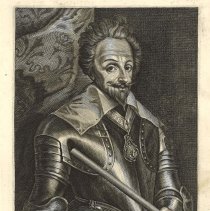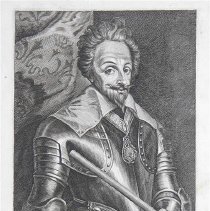Object Record
Images



Metadata
Catalog Number |
1968.002 |
Object Name |
|
Description |
This black and white ink print on paper titled "Iconography" by Sir Anthony van Dyck depicts an etched portrait of Charles Emmanuel, Duke of Savoy in armor carrying a baton. He is shown in contemporary military regalia, wearing around his neck the collar badge of the Supreme Order of the Most Holy Annunciation, which depicts the Annunciation by the archangel Gabriel to Mary. The caption beneath the image reads: "Carolvs Emmanvel Dvx Sabavdiae Princeps / Pedemontanvs Comes Astiensis Etc" This translates from Latin as Charles Emmanuel, Duke of Savoy, Prince of Piedmont, Count of Asti, etcetera. Further caption below reads: "Antonius van Dyck pinxit. Petrus Rucholle sculpsit. Iacobus de Man excudit Antwerpie." This translates from Latin as Anthony van Dyck painted this. Pieter Rucholle carved this. Jacobus de Man printed this in Antwerp. The print likely originates from a Verdussen edition of the Icones principum virorum doctorum pictorum chalcographorum statuarum nec non amatorum pictoriae artis numerocentu, which includes engravings by Anthony van Dyck as well as other Flemish engravers. The Verdussens were a family of printers based out of Antwerp during the 16th to 19th century. Charles Emmanuel was the Duke of Savoy from 1580 until his death in 1630, well known for his military campaign. He notably led the Savoyard state in the War of the Montferrat Succession, which he prosecuted, alongside various other conflicts in northern Italy, including against both France and Spain. Sir Anthony van Dyck was a Flemish Baroque artist famous for his work as a portrait painter. The seventh child of Frans van Dyck, a wealthy Antwerp silk merchant, Anthony painted from an early age and was already accomplished by the age of fifteen, evidenced through his 1613-1614 self-portrait. He began formal training as an artist underneath the tutelage of Hendrick van Balen the Elder at the age of ten, and by 1617, at the age of eighteen, van Dyck was admitted to the Guild of St. Luke as a master. Van Dyck became chief assistant to Peter Paul Rubens and worked with him as late as 1620. Van Dyck traveled to England and worked for King James I in 1620 before travelling to Italy where he would remain until 1627. During his time in Italy, he travelled but was largely based in Genoa. He was quarantined in Palermo during the plague of 1624, where he painted a series of paintings of St. Rosalia, which influenced the iconography of the saint going forwards. After leaving Italy, he served in the capacity of court painter for the Archduchess Isabella of Austria until coming into the employment of King Charles I of England and Scotland. Van Dyck became a prolific influence within the English court, firmly establishing himself and his style, which shaped the stylistic direction of English portraiture for decades to come. Van Dyck died in 1644 from illness, survived by his wife Mary Ruthven and a single daughter. He was successful as an independent painter in his late teens, and became a master in 1618 in the Antwerpen Guild of Saint Luke. By this time he was working in the studio of the leading northern painter of the day, Peter Paul Rubens, who became a major influence on his work. Van Dyck worked in London in 1621, returned to Flanders for a brief time, then travelled to Italy. He stayed in Italy, primarily in Genoa, until 1627. In the late 1620s he completed his greatly admired Iconography series of portrait etchings, mostly of other artists. In 1630 he was court painter for the Archduchess Isabella, Habsburg Governor of Flanders. He later returned to London in 1632 to be the main court painter, at the request of Charles I of England. Pieter Rucholle and Jacobus de Man were involved in the engraving and printmaking scene in the city of Antwerp, Flanders, during the 17th century. Etching is a form of intaglio print which gained popularity during the 16th and 17th centuries as a medium for printmaking. Etching is achieved through the process of cutting, or etching lines into a metal plate. This is done by applying an etching ground to the plate, which is a protective layer comprised of materials such as wax or varnish. The etching ground is this scraped away with a tool to create lines, after which a mordant or acid is applied to the metal. The acid bites away the metal and leaves the carved drawing embedded onto the plate. The grooves left behind by the etching are then filled with ink, which can then be used to impart the etched image onto paper, allowing for the drawing to be easily mass-produced for various uses. The sources used to complete this research can be made available upon request. This artifact was purchased for the Reece Museum permanent collection from Ferdinand Roten Galleries, Inc. circa 1968. |
Date |
1697 |
Artist |
Anthony van Dyck |
Dimensions |
H-29.21 W-25.4 cm |
Collection |
Pre-1900 Art Collection |
Title |
Iconography |
Place of Origin |
Europe/Belgium |
Material |
paper, ink |
Subjects |
International Art |
Search Terms |
International Art |
